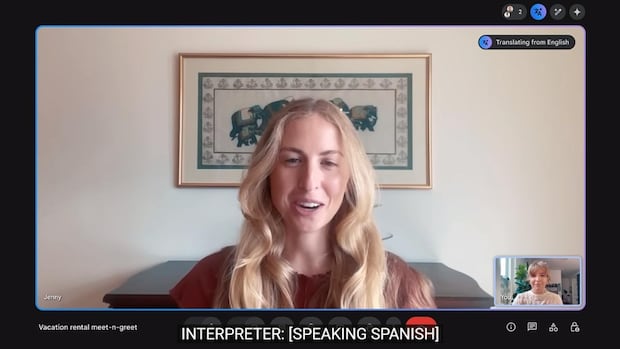The Sunday Magazine21:16Will we still need to learn foreign languages if AI can do the translating?
There’s a suite of new and upcoming tools designed to make translation between languages easier and faster than ever before — some, with the help of artificial intelligence.
At their I/O 2025 event, for example, Google revealed a live translation service it’s added to its Google Meet videoconferencing tool. A demonstration showed two people speaking to each other — one in English, one in Spanish — with their speech translated into the other language with a short, seconds-long delay. The computer-generated voice mimicked the original speaker’s voice and intonation.
Roger J. Kreuz, a professor at the University of Memphis who specializes in the psychology of language, said Google’s live translation demonstration was “a pretty amazing technological achievement,” but its staged nature left questions about how it will work in a real meeting.
“Conversations are rarely as clean as the conversation that we saw in the demo,” he said. “They typically will overlap or interrupt, and I can only imagine the cacophony that would occur if people were kind of excitedly talking back and forth … and voices cutting in and then cutting back out again. How is that controlled?”
Experts caution tools like this raise big questions about what might get lost in translation. Because while tech companies often tout these tools as scientific and objective, language doesn’t really work that way in the real world.
In March, Bloomberg reported that Apple is planning to update their AirPod earbuds to allow them to translate languages from speech it hears on the fly. (Google’s rival product, the Pixel Buds, have had this feature for years, the report said.)
Apple’s reported foray into the live translation game is notable, says WIRED journalist and senior business editor Louise Mataskis, because the company typically doesn’t introduce new tech features as quickly as others.

“They tend to hold back until that technology is really mature and that there is a good sense that it’s gonna be reliable. So I think that this shows that this technology is really starting to mature,” she told The Sunday Magazine’s Piya Chattopadhyay.
Google’s speech translation currently only features translation between English and Spanish, and it’s available only in the U.S. to anyone paying for their Google AI Pro premium services. The company says it doesn’t save users’ audio, no AI models are trained using your voice, and the feature is opt-in only.
A representative from Google told CBC the service will add more languages “in the next few weeks.” They said the feature uses an AI large language model called AudioLM, developed by Google DeepMind.
‘Do you have a toilet in your house?’
Mataskis says language tools can help people practice learning languages, but…
Read More: New AI tools promise real-time translation so you don’t have to. But is



